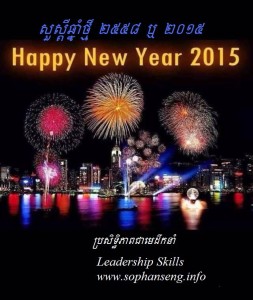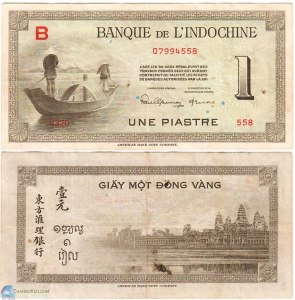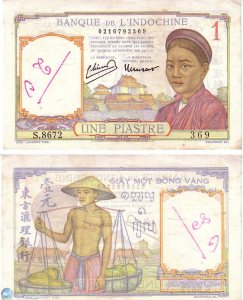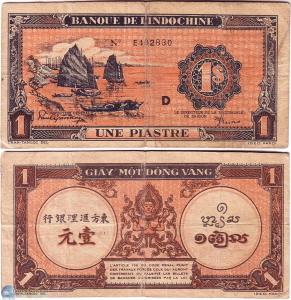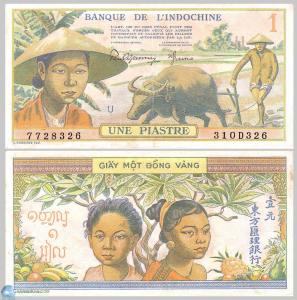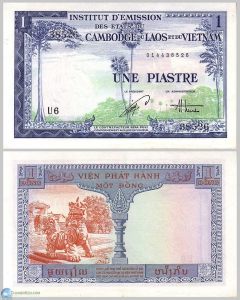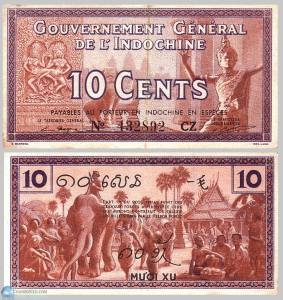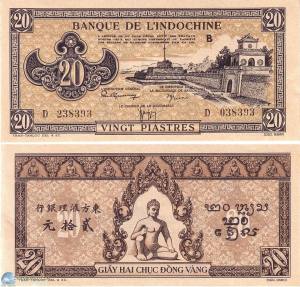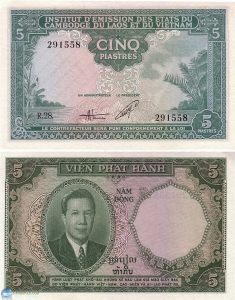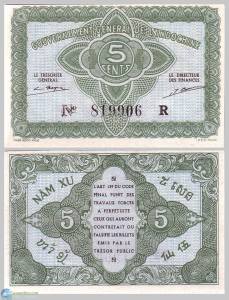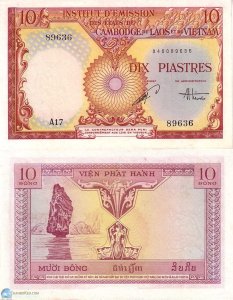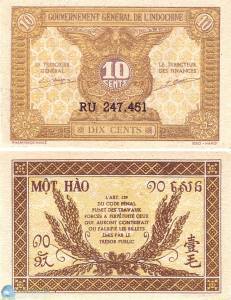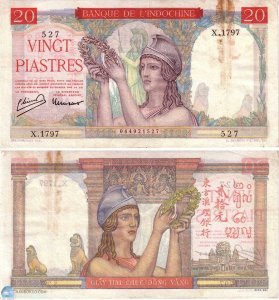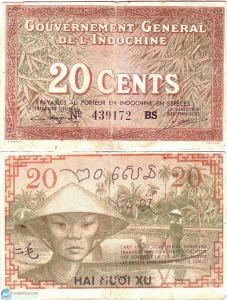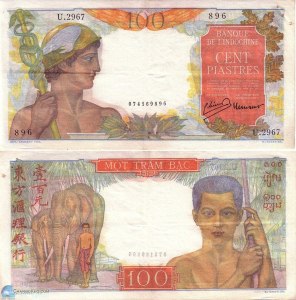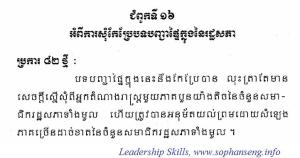Monthly Archives: December 2014
The Cambodia Politics of Nostalgia: From Indochina to AEC 2015
In the meantime, the challenges Cambodia is facing for Asian integration is its slow increase of population including skill labors and strengthening the rule of laws within the country.
- The eyes-catching danger for Cambodia right now is the influx of population flowing from Vietnam. While the population of this country is hiked up to 90 millions, Cambodia is likely existing only 14 millions. The westward travelers of Vietnamese population is encouraged by both geographic frontier that blocks by China vast sea at the East, and their Vietnamese existing networks in Cambodia established since 1979 during more than 20,000 Vietnamese armed soldier trespassed into this country and anchored the power base in this land for more than 10 years.
- Cambodian opposition party, CNRP, must promptly initiate the very jargon present Immigration Laws by introducing new up-to-date Immigration Laws and Laws on Nationality Naturalization and Names Change that other countries have effectively used it. Current Immigration Laws and Laws on Nationality Naturalization don’t respond to reality of Cambodia and to the policy of Asian Integration including its upcoming AEC at all. Some few recommendations, the Immigration Laws and its Control must be under Special Force of National Authority Level, not under the Ministry of Interior as practicing at the Present. While nationality application and name change (?) are under the Royal Decree, the Citizenship Identification Issuance must be under National Authority Level, not under provincial governor as presently practicing etc.
- The Immigration Authority must enforce the Laws and Implement them effectively and equally. As evidence, Cambodia must accept the reality that those remaining Vietnamese populations, at least since 1979, are in large number and omnipresently living throughout Cambodia. Those citizens have not yet been well integrated and naturalized. Of course, those citizens have created their living community in Cambodia before the birth of current Immigration Laws and Its Enforcement. This is odd. And this is imperative to create and effectivate National Level Policy to handle with those populations.
The most reliable way to anticipate the future is by comprehending the past and understanding the present
After indulging into the prolific description of Henry Mouhot for his book “Travels in Siam, Cambodia, Lao and Annam” during his visiting of these countries between 1859-1861 as a nature researcher and explorer (botanic naturalist); I am keen to glancing back to Angkorean period, the Indochina Federation of France, and the Vietnam’s War or the War that can change France Indochina into Vietnamese Indochina. After that, I am keen to looking at the present for different available scenarios to bring back the Spirit of Angkorean the Great for the Future Cambodia.
Recalling the Past of Greatness
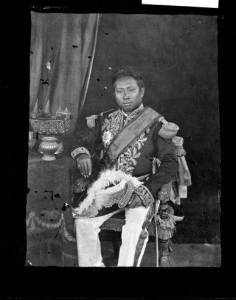
Not need to describe much on the glory of Khmer empire between 8th century to 14th century as those gigantic monuments such as Angkor Wat, Bayon, Preah Vihear, Banteary Srey, Banteay Chmar, and groups of Sambo Prey Kok etc. are still discerning truth for all of us. Henry Mouhot visited Angkor Wat and he was stunned that Angkor Wat was built by Rome or Greece, and it is a world’s famous architect of Michelangilo in this plunged state. Of course, many believed and stated that Henry Mouhot is a botanic researcher (naturalist and explorer), but I am convinced that he is the France’s spy who recorded all treasures, natural resources, and geographic map for France to plan its colonization on this region. He is not different from Chou Ta Kuan who visited Angkor during the 14th century as a Chinese Ambassador but his detailed descriptions were sent directly to Mongol Emperor for conquering attempt on this region while China was a Mongol’s vassal state.
France firstly learnt about Cambodia and the Angkor from a Portuguese Christian monk, António da Madalena , who visited Cambodia during the the 1586. The motivation behind France to arriving Cambodia, Vietnam and Lao, could be variable but I am believed, France was inspired by the Greatness of Angkor Wat depicted by Henry Mouhot, and the Official Invitation by the Khmer King Ang Duong. Many scholars wrote that France favoured Vietnam more than Cambodia and Lao as Vietnamese were so welcoming to the arrival of France including their subservient attitude, diligent, industrious, and more populated than Cambodia and Lao. But my argument is that France took their accessibility as a key decision-making by creating head-quarter in Vietnam as during that time only through China’s Sea that France can embark and transfer manpower and goods. France’s base in Vietnam is important to go through Cambodia and Lao, to Thailand, and to counter England in Burma.
France created Indochina currency by using Vietnamese (Chinese pictographs), Laotians and Khmer scripts within all money bank-notes (see above bank-notes photos: courtesy of Keo Chanbo). France employed Vietnamese to work more than Cambodians and Laotians. France built schools and universities in Vietnam, not in Cambodia and Lao.
Cambodia in Between China and America
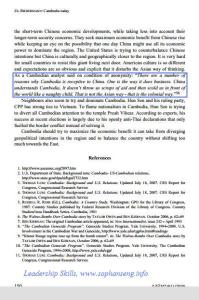 After reading this article “Cambodia today or is China eating America’s lunch in South East Asia” by Zsuzanna Biedermann published in 2010, I am recalled to the previous article on “Geopolitics right of Cambodia in between China and Vietnam“. The article reminds us on how important China run faster than America in Cambodia as well as in South East Asia countries. One of the Chinese’s top lines is the ethno-Chinese population living in Cambodia and those countries. Chinese-Cambodians and Cambodian-Chinese are very receptive to total Cambodian population.
After reading this article “Cambodia today or is China eating America’s lunch in South East Asia” by Zsuzanna Biedermann published in 2010, I am recalled to the previous article on “Geopolitics right of Cambodia in between China and Vietnam“. The article reminds us on how important China run faster than America in Cambodia as well as in South East Asia countries. One of the Chinese’s top lines is the ethno-Chinese population living in Cambodia and those countries. Chinese-Cambodians and Cambodian-Chinese are very receptive to total Cambodian population.
The author also repeated the saying that “There are a number of reasons why Cambodia is receptive to China. One is the way it does business. China understands Cambodia. It doesn’t throw us scraps of aid and then scold us in front of the world like a naughty child. That is not the Asian way – that is the colonial way.”.
Hence, Vietnam’s policy to dominate Cambodia and Lao is just their exit way from China’s hegemony. In some situation, China can oversea all Vietnamese desires to counter-strike its hegemony, but China could not see the Vietnamese waves flowing under the water surface – the infiltration of Vietnamese populations through intermarriage, accustomization and acculturalization such as changing the last name and first name, dressing the local traditional etiquette, and speaking the Khmer and Laotian language etc.
Institution Building through Absolute Majority or Half plus One in the Assembly
Preamble:
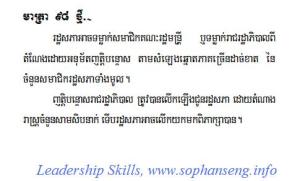 There are continual blame-games on Sam Rainsy who proposed CPP to amend the Constitution from Two Third Majority to Half plus One Majority, or Absolute Majority vote in the Assembly to create a new government. In 2006, the Cambodia Daily described in details this new approach that was in tense and government sent armed-security to safeguard Sam Rainsy by the proposal of opposition party members. From different perspectives, the move is a good choice to create a “Two Parties State” of Cambodia for a long run future. It has also encouraged the winning party to executing their executive members into more Responsible, Accountable, and Removable. Click on this link for numeral systems concerning Cambodia’s Political System of Assembly.
There are continual blame-games on Sam Rainsy who proposed CPP to amend the Constitution from Two Third Majority to Half plus One Majority, or Absolute Majority vote in the Assembly to create a new government. In 2006, the Cambodia Daily described in details this new approach that was in tense and government sent armed-security to safeguard Sam Rainsy by the proposal of opposition party members. From different perspectives, the move is a good choice to create a “Two Parties State” of Cambodia for a long run future. It has also encouraged the winning party to executing their executive members into more Responsible, Accountable, and Removable. Click on this link for numeral systems concerning Cambodia’s Political System of Assembly.
Absolute Majority within the National Constitution and Internal Regulation of the Assembly is Blurry:
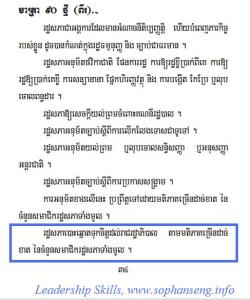 Last time I wrote “the people must hold government accountable and responsible, in which the government cabinet is answerable to, and removable by, the majority of parliamentarian” in which Majority here is very interesting.
Last time I wrote “the people must hold government accountable and responsible, in which the government cabinet is answerable to, and removable by, the majority of parliamentarian” in which Majority here is very interesting.
Majority could include “Simple Majority”, or “Absolute Majority”, or “Super Majority”. Here, I am going to articulate more on Cambodia’s adopted Majority or “half plus one” or “50% + 1” in which it is fallen into “Absolute Majority”. Majority itself could be mandated through all 120 Cambodian law-makers, or just those who are presenting during the vote. The internal rules of Cambodian assembly dictates that it must represent the whole 120 of parliamentarian in according to Article 41 (new) but it is already inscribed in the Constitution (pic attached). When I looked at Constitution in Article 90, it has still used unclear term “Absolute Majority”, or this version is too old (has not yet included the new amendment yet) (pic attached).
The National Assembly can dismiss any minister or the Royal Government from office by adopting “Blaming Notification” based on the absolute majority of the whole parliament members.
The Blaming Notification on the Royal Government must be raised to the National Assembly by at least 30 MPs so that the National Assembly can discuss it.
Institution Building through this Absolute Majority or Half + 1:
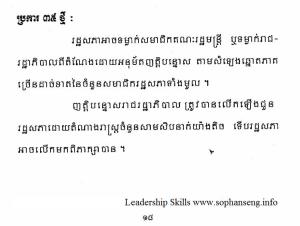 Firstly, truly, Sam Raimsy has projected long term scenario for Cambodia future by putting all efforts since he has become opposition leader. His leadership and method to adopting half+1 is to ensure that Cambodia future change shall be a democratic system of two political parties state. His prediction is correct with the current rolling wheel of the CNRP and CPP.
Firstly, truly, Sam Raimsy has projected long term scenario for Cambodia future by putting all efforts since he has become opposition leader. His leadership and method to adopting half+1 is to ensure that Cambodia future change shall be a democratic system of two political parties state. His prediction is correct with the current rolling wheel of the CNRP and CPP.
Secondly, the key points to implement this new Assembly formula is to alter all political non-will of other parties that have been created to just a pawn or a tool or a decor for the government-led party. It has tremendously discouraged corruption and inefficiency of pluralism.
Thirdly, to actualize the concept of “government of the people, for the people, and removable by the people”. Or it is popularly to say “the people must hold government accountable and responsible, in which the government cabinet is answerable to, and removable by, the majority of parliamentarian”. At the moment, the government-led party CPP has no excuse by assigning blames to any coalition party as the party alone must be responsible, answerable, and removable.
The Goodness and the Challenges of Institution Building Processes:
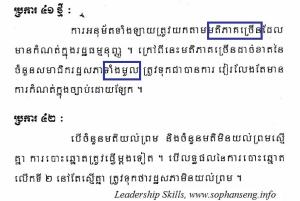 Buddha said “Everything is impermanent (Anicam), decaying (Dukkham), and non-substantial (Anatta). All beings are born, aged, sick, and dead”. Hence, the Buddha established the Sangha institution in which this principle community has survived without focusing much on manpower but using pure principles or Rule of Laws. Buddhist Sangha has lasted more than 2558 years today.
Buddha said “Everything is impermanent (Anicam), decaying (Dukkham), and non-substantial (Anatta). All beings are born, aged, sick, and dead”. Hence, the Buddha established the Sangha institution in which this principle community has survived without focusing much on manpower but using pure principles or Rule of Laws. Buddhist Sangha has lasted more than 2558 years today.
However, the Establishment of Institution is a double-edged sword. A strong Institution could be successful when the principles and institution itself is aiming towards a progress. Historically speaking, Khmer Rouge regime is known for the Demolition of Political Institution. But the arrival of Vietnamese force in the 1979 to replace the Khmer Rouge, has been known for its effort to Establish an Institution. Scholars and observers have noticed that the Institution that has been created by Vietnam since 1979 has remained its lifespan till today, and it is still evidently proven to all of us.

